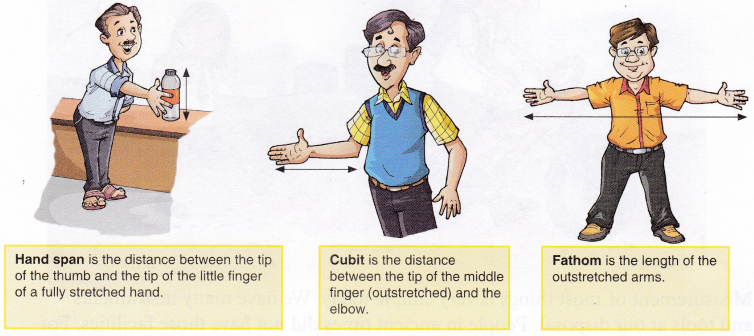What Is Measurement In Physics
Measurement is the process of finding the length, size, or quantity of a substance. Since ancient times, people have used several ways to measure length. A physical quantity (like length) has to be measured with respect to some fixed quantity. A fixed quantity with respect to which a physical quantity is measured is called a unit. A unit is used as a standard of measurement. In early times, people used different body parts like hand span, cubit, and fathom to measure length.
 Foot, pace, and yard are some other units of length based on body parts. However, these units are not reliable as the length of body parts varies from person to person. Therefore, people realized the need for
Foot, pace, and yard are some other units of length based on body parts. However, these units are not reliable as the length of body parts varies from person to person. Therefore, people realized the need for
Standard Units of Measurement
Standard Units of Measurements Units that have a fixed quantity and do not vary from person to person and place to place are called standard units. For example, the metric system, created by the French in 1790, is a standard set of units.
Adopting standard units of measurement does not solve the problem. People in different countries may be using a different set of standard measurement units. For the sake of uniformity, scientists all over the world have adopted a common set of units. This system is called the International System of Units or the SI units. The adoption of SI units in 1960 made it easier for scientists of different countries to communicate their results to one another.
The SI unit of length is metre. Some common standard units of length are inch, millimetre, centimetre, and kilometre.
Depending on the size of the object, we need to measure, we have to choose an appropriate unit. For example, we use metres to measure the length of a piece of cloth, kilometres to measure the distance from one place to another, millimetres to measure the thickness of the hair, and so on. Centimetre (cm) and millimetre (mm) are used to measure shorter distances while kilometre (km) is used to measure longer distances.
One kilometre is divided into 1000 equal divisions, each called metre. One metre is divided into 100 equal divisions, each called centimetre which is again divided into equal divisions. Each division is called millimetre.
Commonly used units of length:
10 millimetres = 1 centimetre (cm)
100 centimetres = 1 metre (m)
1000 metres = 1 kilometre (km)
A unit can be converted to another. Here is an example.
Example 1: Raju and his friend Akhil live 2000 m from each other. Express the distance between their houses in kilometres (km).
Solution: We know that 1000 m = 1 km
Therefore, 2000 m = 2 km
Therefore, the distance between the two houses is 2 km.
